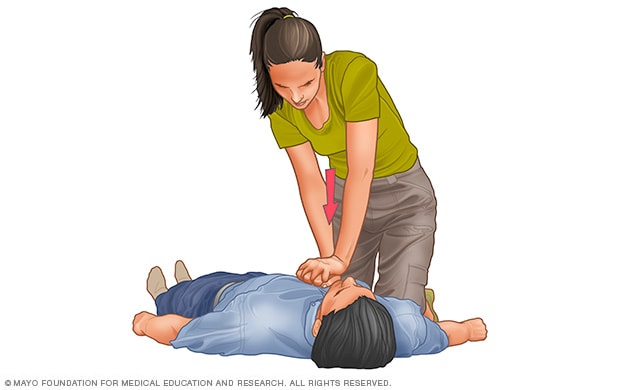During heart attack the first thing to be done is giving CPR to the victim.
Here are a Few of the Warning Signs CPR Might Be Needed:
- Sudden Collapse:Check for breathing and a pulse
- Unconsciousness: Try to wake the person. If unsuccessful, check for breathing and pulse.
- Breathing Problems: No breathing or limited breathing may call for CPR.
- No Pulse: If a pulse can’t be felt, the heart may have stopped.
- Electrocution Injuries: If you witness an electrical injury. Do not touch the victim. Try to kill the power source or remove the victim from the electrical contact, but be sure to use something that doesn’t conduct electricity, like a wooden broom or stick.
- Drowning, Drugs, Exposure to Smoke or Inhalants: Check for breathing and a pulse. Injuries of this nature might call for a combination of rescue breathing and chest compressions.
• If its a heart attack then :-
The first and the most important thing is not to panic and be calm and relax. Try to observe the person who had an heart attack .!!! Make him lay on the floor rub hi hand and feet . Try to give him CPR ( Cardiopulmonary resuscitation ) do it only if you know it properly and if not then called the ambulance as soon as possible . CPR Is a chest compression and artificial ventilation to maintain circulation of blood. It should be performed immediately on the person who is pulseless . it should be rhythmic and continous .It is the most basic form that can be done anywhere without any equipment.
• Basic life support comprises the following elements:
∎ Initial assessment
∎ Airway maintenance
∎ Cardiopulmonary Resuscitation (CPR).
• The following steps are followed for CPR process.
1. Make him lay on floor or a plane surface from back side.
2. Deliver him chest compression by overlapping hands placed on the center of the sternum and interlaced the fingers atleast 2 inches ,release the chest and allow it to recoil it properly chest compression are to be delivered at a rate of atleast 100 compressions per minute .
3. Then deliver mouth to mouth ventilation. and block the airway ie nose

4. After 30 compressions , 2 breaths are given .

5. To prevent fatigue of provider the provider is changed and a new provider is assign ,provider should be changed after every 2-3 minutes .
• The time needed to deliver the first two rescue breaths was between 12 and 15 s. The average time to complete five cycles of CPR is approximately 2 min for newly trained BLS/AED providers and the majority of the participants found it easier to perform five cycles.
• The new guidelines do not have any major changes, but here are some of the basics: No more than 120 compressions per minute with a minimum of 100. Chest compressions for adults should be no more than 2.4 inches and at least 2 inches.
• Precautions
(ie, gloves, mask, gown) should be taken. However, in the vast majority of patients who are resuscitated in the out-of-hospital setting, CPR is delivered without such protections, and no cases of disease transmission via CPR .
• Here is the link to perform CPR ...
https://www.youtube.com/watch?v=O9T25SMyz3A

Comments
Post a Comment